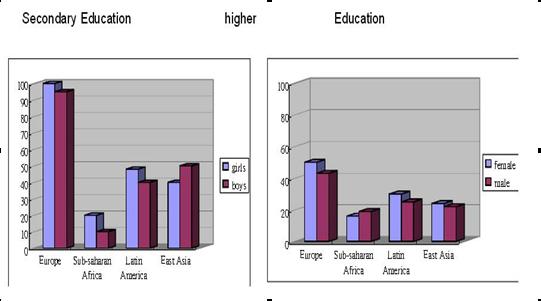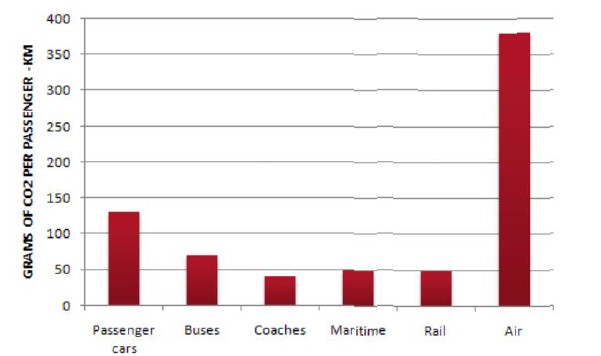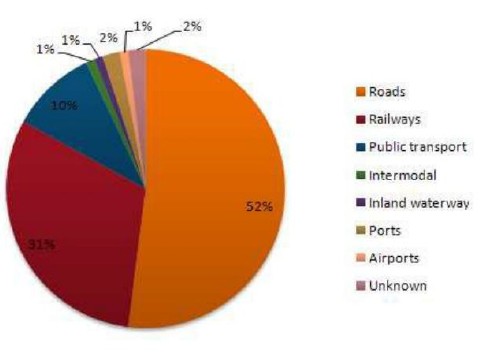雅思写作之经典柱状图范文两篇
在雅思写作中,同学们不仅要积累大量的词汇和各种语法知识,适当的范文学习更有必要,下面成都新航道小编就为大家收集了雅思柱状图形写作范文供大家学习。
雅思柱状图范文1:
You should spend about20 minutes on the task.
The bar chart below shows the number of male and female students studying at secondary and higher levels of education across Europe, Sub-Saharan Africa, Latin America and East Asia.
Write a report for a university lecturer comparing and contrasting the information from the two charts below.
You should write at least150 words.

The graphs illustrate the percentage of males and females studying at secondary and higher levels of education in Europe, Sub-Saharan Africa, Latin America and East Asia. As can be seen from the graph, the overall trends generally suggest that more male and female students attend secondary education than higher education across these parts of the world, with females proving to be slightly higher than males.
Firstly, in regards to Europe, males and females studying at a secondary education level peaked at nearly100% but declined to just under half that amount for higher education. However, in Sub-Saharan Africa secondary education was much lower with females reaching only19% and males10%.
A similar low level of higher education exists for Sub-Saharan students with females falling to16% and males sharply rising to18%.
Latin America and East Asia both show a similar decline from secondary to higher education with Latin American males and female’s numbers falling from47% to27%, and39% to22% respectively, and East Asian males and female’s numbers dropping from39% to21% and50% to21% respectively.
In conclusion, apart from male students in Sub-Saharan Africa, generally higher education seems noticeably less popular for male and female students in these parts of the world.
雅思柱状图范文2:
The table below shows CO2 emissions for different forms of transport in the European Union.

The pie chart shows the percentage of European Union funds being spent on different forms of transport.

model answer:
The chart shows CO2 emissions per passenger kilometre for various methods of transport in the European Union while the pie chart shows European Union spending on transport. Flying by air produces by far the greatest CO2 emissions, approximately three times as much as passenger cars which are the next largest producers. Very little is spent by the EU on air travel while roads make up more than half of the EU transport budget.
Trains produce about three times less CO2 emissions per passenger kilometre than passenger cars and eight times less than air travel. Nearly a third of EU transport funds are spent on railways.
Ships are a clean form of transport and produce about the same amount of CO2 per passenger kilometres as trains do. However, only2 percent of EU funds are spent on ports. A further one percent is spent on inland waterways.
Coaches are the cleanest form of transport. Emissions of CO2 per passenger kilometre from coaches are half those of buses. Buses emit less than half as much CO2 per passenger kilometre as cars. The European Union spends10 percent of its transport budget on public transport, such as buses and coaches.
【推荐阅读】
雅思写作课程中心
查看更多 >- 雅思入门36小时 新航道成都学校雅思入门... 雅思基础,雅思基础培训,雅思培训班,雅思基础培训班,雅思入门段,成都雅思入门段 在线咨询
- 雅思精讲72小时 新航道成都学校雅思精讲... 雅思精讲培训班,新航道雅思,成都雅思培训班,成都雅思精讲培训班,雅思精讲培训班 在线咨询
- 雅思“飞跃计划”套餐课程 成都新航道雅思“飞跃计... 雅思飞跃计划,雅思套餐课程,雅思6分班,雅思6.5分班 在线咨询
- 雅思“卓越计划”套餐课程 成都新航道雅思“飞跃计... 雅思卓越计划,雅思套餐课程,雅思6分班,雅思6.5分班 在线咨询
- 雅思写作批改卡 成都新航道雅思写作批改... 雅思写作批改卡,成都雅思写作,成都雅思写作批改卡 在线咨询
- 鲸小爱口语 成都新航道鲸小爱口语系... 鲸小爱口语,成都英语口语培训,雅思口语培训,托福口语培训 在线咨询
雅思快讯
- 雅思评分标准及正确率成绩... 2024-03-07
- 成都雅思课程学费多少一期 2024-02-27
- 雅思考试机考多少时间出成绩 2024-01-16
- 雅思考试听说读写哪个部分难 2023-11-09
- 雅思考试一般在哪考比较容易 2023-11-07
